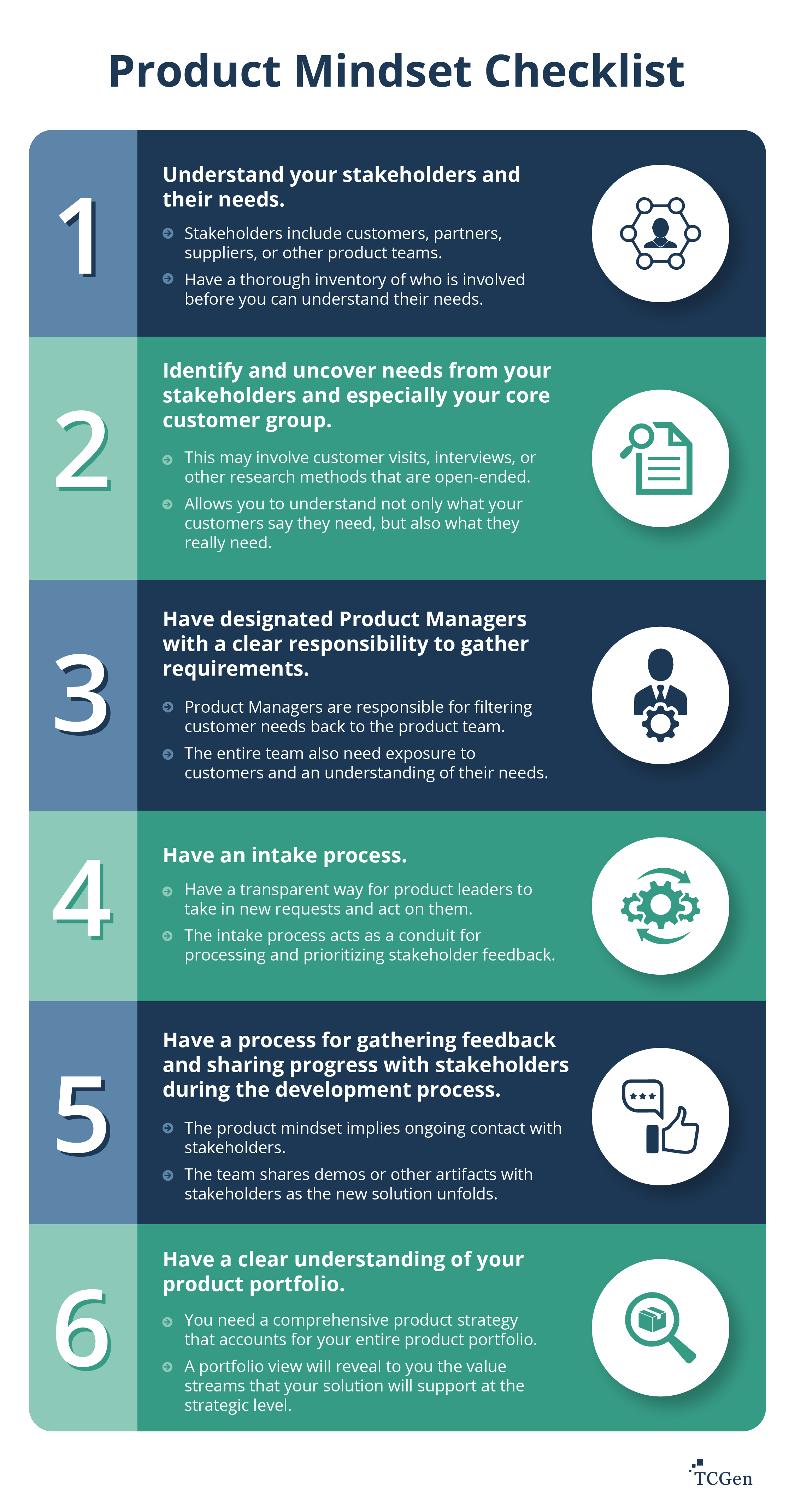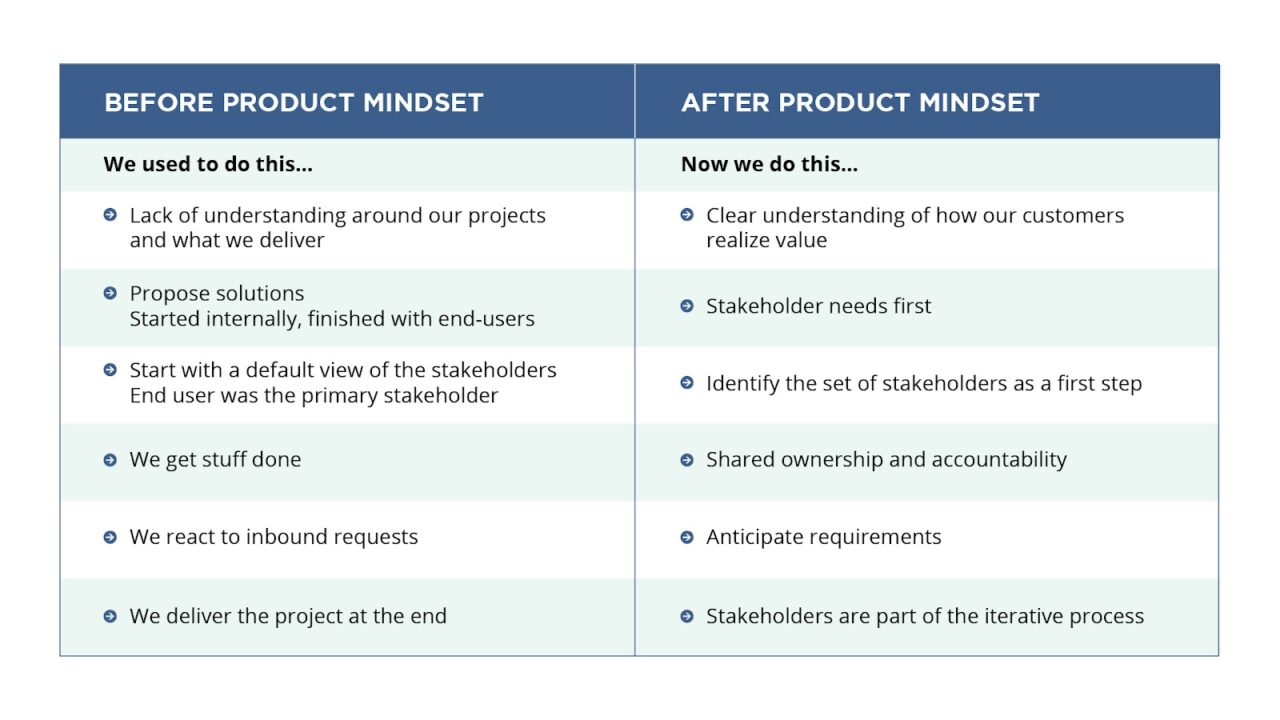What is a Product Mindset?
A product mindset is nothing more than a single-minded focus on creating meaningful value for customers before all else. The Scrum Guide 2020 defines a product as “a vehicle to deliver value. It has a clear boundary, known stakeholders, and well-defined users or customers.” It can be a designed physical object, a service, or a more abstract offering.
A product-focused mindset, therefore, means a better understanding of stakeholder requirements to deliver increments of value faster that meet or exceed user needs.
Common elements included in product mindset
- Defining your customers (and all stakeholders)
- Beginning with user needs
- Focusing on the needs to drive the solution
- Getting continuous feedback from users
- Placing outcomes before output – while managing both!
- Enabling solution-free discovery
- Aligning your organization with products

What Are the Benefits of a Product Mindset?
A product mindset is essential because it enables your company to deliver more excellent value to users – and value that continues to improve – while boosting your productivity and innovation. This mindset informs product decisions throughout the development lifecycle, ensuring they are constantly aligned with user needs and market trends.
The benefits of product-focused thinking include the following:
- Improved customer satisfaction
- Better execution on your” North Star”
- Higher overall business value coming from your teams
- Faster delivery of incremental value to customers
- More adaptable teams focused on business value
The synergy of the product mindset approach and product management
The product-focused mindset and product management are essential drivers of success in product development. Product mindset thinking fosters a customer-focused approach, encouraging experimentation, collaboration, and a smoother decision-making process. Product development management brings this mindset to life, strategically planning and executing products throughout their entire lifecycle. Together, they create a powerful synergy that fuels innovation, enables continuous learning, and drives a sustainable growth mindset. KPIs (Key Performance Indicators) are crucial benchmarks to track progress and measure success throughout this process. When embraced and nurtured, this synergy and focus on continuous improvement empower organizations to create successful products that resonate with customers, deliver value, and achieve high retention, standing the test of time even in the face of short-term challenges. This focus also ensures that efforts are directed toward developing features and enhancements that genuinely benefit the customer.
Product mindset and digital transformation success
Digital transformation and product-focused thinking go hand in hand in today’s rapidly evolving business landscape. Digital transformation involves leveraging technology to reimagine and optimize business processes, customer experiences, and overall operations.
With its customer-centric approach and focus on innovation, the product mindset plays a pivotal role in driving and guiding digital transformation initiatives. It brings forth several benefits, including:
- Accelerates innovation
- It’s customer-centric
- Encourages agility and adaptability
- Creates an iterative, data-driven approach
- Fosters cross-functional collaboration
These advantages are instrumental in empowering organizations to navigate and thrive in a post-pandemic environment.
Who Needs a Product Mindset?
A product-oriented approach is for everyone in your organization, from the C-suite to the individual contributor. Some organizations teach it to everyone, not only to product teams but also to HR and Finance. It is not the sole job of Product Owners or Product Managers but also of a more comprehensive set within your ecosystem. The product mindset approach is about creating business outcomes, which applies to everyone in the organization.
A product-oriented approach that cascades throughout your organization allows you to excel at managing change and focus like a laser beam on customer needs. This focus, emphasizing validation through continuous learning and feedback, is required in our digital economy, whether you’re a large corporation’s vice president or a startup’s first employee.
A product-driven approach is for everyone since it encourages everyone in your organization to question assumptions, ask how a job can be done better, and innovate with customers and business value in mind, which increases the overall digital economy.
From a Project Mindset to a Product Mindset
A mindset, by definition, is not a process or set of procedures that you can take off the shelf and implement. It’s not a tool or a technique. It is broader than that. It involves cultural change and a change in perspective. However, some steps that most organizations take include:
- Defining your “North Star”
- Defining your stakeholders (broader than just users)
- Having roles such as “product manager” or “product owner”
- Designing an intake process for customer requirements
- Creating opportunities to validate the solution with stakeholders continuously
Transforming from a project mindset to a product mindset requires some subtle shifts. Consider the following before and after scenarios:

To illustrate this shift further, imagine a digital product team that knows its technology, understands the features it must develop, and can create excellent designs. This product development team has superb project management skills and a tight metrics dashboard. It uses selected scrum methodologies, such as managing the backlog and creating a minimum viable product (MVP). It has everything in place but is deficient concerning its product mindset. What can that team expect?
Such a software development team cannot comprehend a customer’s problem and needs richly and in their full context. Since this team has little contact with customers, including their user experience, it struggles to create meaningful personas or user stories. It is isolated from the larger context, like DevOps practices, regarding its customers and the internal product portfolio. Such a team leaves the opportunity to deliver customer value and optimize functionality. It will fail to take advantage of synergies between products, and it is unlikely to realize the total business value of its new offering. It might deliver a great product but may not be the right one.
Fostering a Product Mindset
Since a product mentality is a product of cultural change, you cannot implement it off the shelf. Senior product leadership must foster and cultivate it. Here are some of the steps you can take to begin this process:
- Understand your stakeholders and their needs.
Stakeholders include customers, but the list does not end there. It may also have partners, suppliers, or other product teams, which often do not clearly understand their stakeholders, let alone what they need. It would be best to thoroughly inventory who is involved before you can understand their needs and the solutions that will meet them.
- Identify and uncover the needs of your stakeholders, especially your core customer group.
You need to get close to all of your stakeholders. This may involve customer visits, interviews, or other open-ended research methods that allow you to understand what your customers say they need and what they really need (they’re not necessarily the same thing).
- Have designated Product Managers or Product Owners with a clear responsibility to gather requirements.
Product Managers are responsible for filtering customer needs back to the product team. This is their unique responsibility, although the entire team, and those beyond the team, also need exposure to customers and an understanding of their needs. However, it is essential to have product groups/teams who represent stakeholders to the product team and champion their perspectives.
- Have an intake process.
An intake process is a transparent way for product leaders to take in new requests and act on them. The intake process acts as a conduit for processing and prioritizing stakeholder feedback. If feedback appears here and there throughout the development process, the result can be incoherence and lack of direction. A formal intake process, led by a senior person who encompasses marketing and technical capabilities, is the special sauce that can make the difference in creating solutions customers love.
- Have a process for gathering feedback and sharing progress with stakeholders during development.
The product-driven approach implies ongoing contact with stakeholders. It’s not a matter of gathering customer feedback and then disappearing to develop your product. You need an ongoing cycle where the team members can share demos or other artifacts with stakeholders as the development of the new solution unfolds. Ideally, your product development process enables you to receive iterative feedback throughout the development cycle. - Have a clear understanding of your product portfolio.
More than just a product roadmap, you need a comprehensive product strategy that considers your entire product portfolio. A portfolio view will reveal the value streams your solution will support strategically.
A Defined Intake Process: The Secret Sauce
Many organizations miss the opportunity to have a well-defined intake process for customer feedback when fostering a company-wide product-focused mindset. This can lead to a disconnect between the customer’s needs and the product’s direction. While many companies carefully collect stakeholder requirements, they lack a single channel for communicating this feedback, including customer pain points, to the team and other internal parties. This creates a fragmented market view, making it difficult to translate the feedback into a cohesive product vision that truly addresses customer needs.
A well-defined intake process:
- Clarifies how the team requests, accepts and prioritizes work
- Helps avoid injecting work via a back-channel
- Has a single plan of record
- Sets realistic expectations for stakeholders
- Provides a transparent view of the priorities of stakeholder’s needs
This process requires a relatively senior leader to manage it. This is often a General Manager, a project management team, or someone senior to the Product Manager. While the Product Manager represents the stakeholder perspective on the team, the intake process channels this perspective, along with general managers’ input, into a stream of work that becomes actionable for a project team. It prevents the team from becoming overwhelmed by too much feedback and keeps its priorities in line and in view.
A Product Mindset and Portfolio Management
Product portfolio management is essential to a product mindset because it encompasses the entire set of solutions your company offers its stakeholders. Any new solution cannot be divorced from this context. Your product portfolio forms the context in which you offer new solutions and technologies.
Product portfolio management answers these questions:
- Which programs deserve the biggest investment?
- How should we allocate our R&D and Marketing budgets?
- What should be our product mix?
- Incremental improvements to core products
- Adjacent markets
- New-to-the-world products
- How should we shift to faster-growing markets?
- How can we capture greater market share?
Although product portfolios help you manage a basket of potential new product development activities, they also play a crucial role in fostering a product mindset. By incorporating market research, analysis of market trends, and user feedback, product portfolios enable you to understand how individual products fit into the overall product strategy and contribute to achieving shared goals. This analysis helps assess risk/return potential and ultimately validate the product’s value proposition. A well-developed product portfolio view ensures you don’t invest in a single product in isolation. It helps you leverage your product platforms to determine the best solution for your stakeholders, aligning your offerings with both internal capabilities and external market demands.
Product Mindset: In a Nutshell
It is often said that a product-focused mindset means focusing on outcomes and not output. The truth is that you must focus on both. The real shift that comes with a product way of thinking is from solutions developed once and for all, in isolation, to solutions developed with the whole context – inside and outside your organization – in mind. It means focusing on business needs and business values rather than new features or technologies alone. And it involves everyone in your organization. A product-driven approach mindset is not a “one and done” approach; it involves plans for continued support over many releases to ensure stakeholder outcomes are realized. A product mindset is applicable across industries. Whether you are engaging in product development of a medical device or a new cosmetic line, the principles remain constant.
With a product-focused mindset, you never say, “We’re doing it this way because that’s how we do things.” Instead, it encourages people throughout your organization to question assumptions, ask “why”(at least five times), and profoundly understand all stakeholders and their needs. It’s not just for the product manager or the development team. A product mindset is a cultural shift. And that means it’s for everybody.

